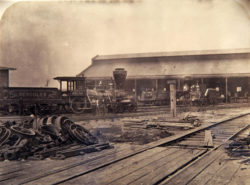Jay Dearborn Edwards
Jay Dearborn Edwards was among the earliest photographers to document the city of New Orleans.

Courtesy of The Historic New Orleans Collection
Jackson Railroad Yard, Central City. Edwards, Jay Dearborn (Photographer)
Jay Dearborn Edwards was among the earliest photographers to document the city of New Orleans. In the three years leading up the Civil War, he appears to have made at least 118 “Views of New Orleans.” As noted in the catalogue accompanying a 2008 exhibition at The Historic New Orleans Collection, Edwards’ photographic series represents the earliest paper prints made in the city. In 1860, twenty years after Jules Lion exhibited the first photograph in New Orleans, Edwards was one of three recorded daguerreotypists in the city. By comparison, more than thirty portrait painters advertised in the city directories. Printing on paper allowed Edwards to create images that were larger than even rare full-plate daguerreotypes (6 ½ x 8 ½ inches). His vision of the city offers a remarkable compendium of construction, shipping, and business activity. Although he rarely focused on the human countenance, Edwards captured the full sense of the nation’s third-largest port at its antebellum height.
Jay Dearborn was born in 1831 in Andover, Massachusetts, to Edwin and Mahala Sanborn Moody, the eldest of four sons. After his father’s death in 1842, he moved in with an aunt and changed his name to Edwards. Little is know of his early career, but according to family tradition, he left Lowell, Massachusetts, at age 17 to lecture about the pseudo-science of phrenology. Edwards married Mary Elizabeth Ogle in St. Louis in 1856. About a year later, the couple moved to New Orleans. Edwards had begun experimenting with photography by this point, using the complicated wet-plate collodion process, often working outdoors in what he called his “queer-looking wagon.” From glass negatives, he printed paper negatives sensitized with sodium chloride and silver nitrate.
His earliest known photographs, dating from 1858 or 1859, such as Steamer Princess, reveal a high degree of craft and aesthetic sensibility. Edwards formed a partnership with E. H. Newton Jr., an otherwise obscure figure. Their Gallery of Photographic Art was located at 19 Royal Street. According to an 1860 advertisement, the gallery sold “Views of New Orleans, the Bayous, Swamps and Shell Piles of Louisiana, Lowell Cotton Factorys [sic], Niagara Falls, Mount Vernon, Washington, Philadelphia, New York, Boston, . . . St. Louis, Mo. Constantinople, Turkey Rome, &c, &c., for sale at the Gallery cheap . . . Stereoscoptic views of any part of the world obtained to order.” Edwards and Newton almost certainly used the glass plate collodion process to copy the works of other photographers.
Edwards received a commission to photograph the Custom House in 1860, taking the opportunity to also create iconic images of commerce from the roof of the structure. With Southern sympathies, Edwards photographed Fort Barracus in Pensacola, Florida. On May 16, 1861, the editor of the New Orleans Daily Crescent wrote that Edwards’s views of “Barracus, Pickens and McRae . . . are really fine, and will prove interesting souvenirs long after ‘war his lost its terrors.’” Northern officers had a somewhat different opinion; after copies of photographs of forts were discovered in the house of Stephen S. Mallory, secretary of the Confederate Navy, Edwards was branded a spy. Fleeing New Orleans for Richmond in 1862, he worked as a courier in Virginia. Ironically, his brother Edward Moody, a Union solider, died in the notorious Libby Prison in Richmond without his family’s knowledge.
Edwards abandoned photography for many years, dealing in china and glassware and later serving as keeper of the Cape Henry Lighthouse on the Chesapeake Bay until he was dismissed in 1885, likely on political grounds. Edwards opened a photographic studio in Atlanta, Georgia, in 1886, working with his son, Willy, and, for a time, his son-in-law, Lewis Karl Dorman. Described as “one of the best known Masons in the state,” Edwards was highly respected in Georgia—meriting a twelve-block-long funeral procession upon his death in 1900.
Edwards was among the first to recognize the market for high-quality photographs of New Orleans, anticipating by a generation the iconic city views of George François Mugnier and Theodore Lilienthal.
